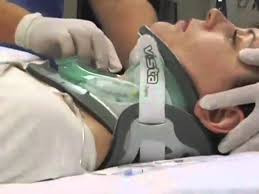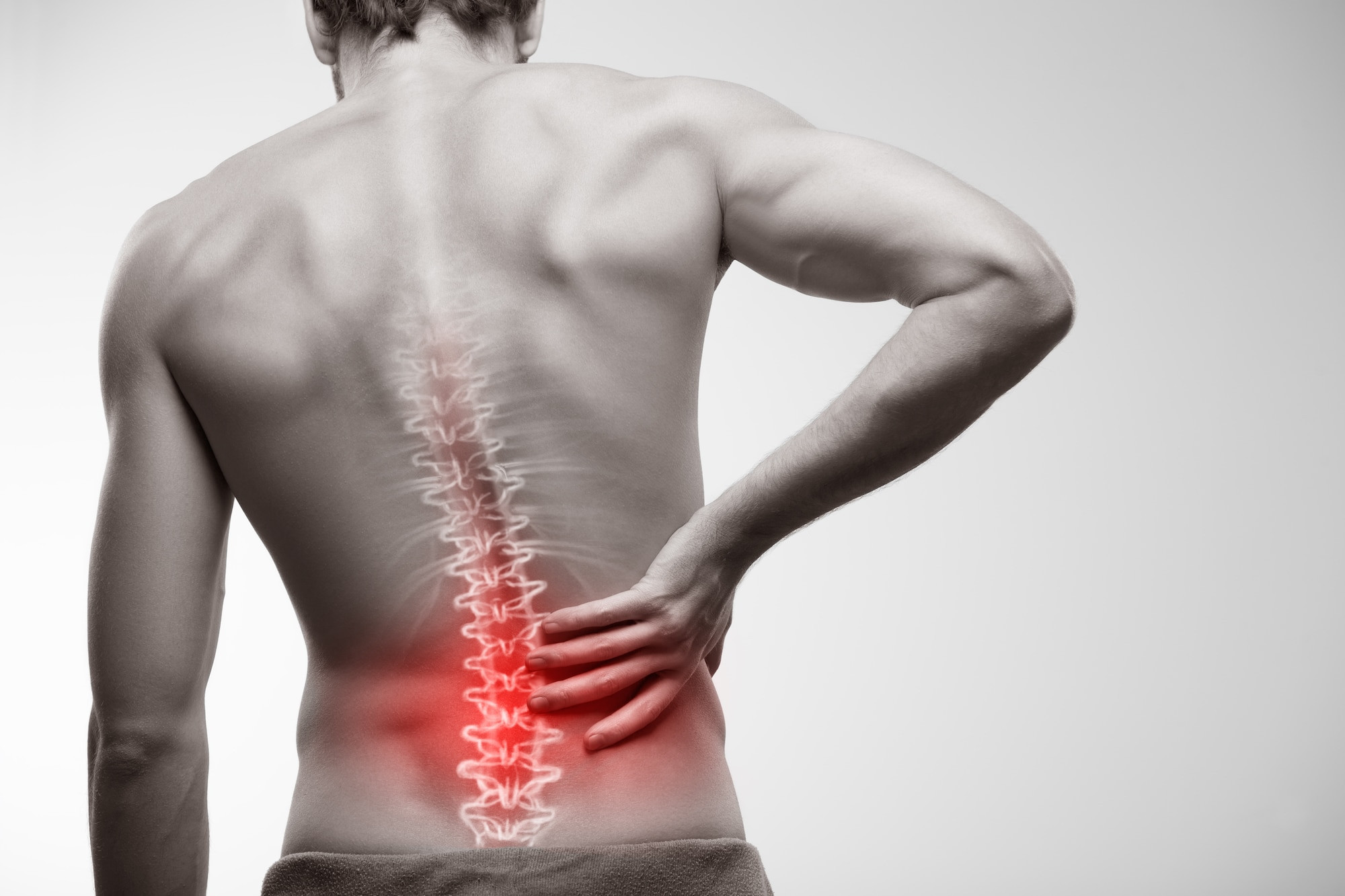Definisi
Trauma servikal adalah cedera tulang leher akibat energi mekanik. Selain tulang, cedera servikal juga mencakup cedera pada sumsum tulang belakang dan jaringan sekitar leher. Meskipun jarang, kondisi ini dapat mengakibatkan kelumpuhan jangka panjang.
Tulang servikal atau tulang leher adalah segmen tulang belakang yang terletak paling atas di belakang leher. Tulang servikal berjumlah tujuh buah dan berfungsi melindungi sumsum tulang yang berada di dalamnya. Tulang servikal adalah segmen tulang belakang yang paling rentan terhadap cedera karena letak dan fleksibilitasnya. Tulang yang sering mengalami cedera adalah daerah servikal 2, 5, 6, dan 7.
Penyebab
Kecelakaan kendaraan bermotor dan kejadian jatuh, masing-masing menyumbang 50% dan 20% cedera tulang belakang leher. Studi terbaru menunjukkan bahwa faktor kekuatan tabrakan, usia pengemudi 65 tahun atau lebih, dan kecelakaan dengan kondisi terguling secara signifikan meningkatkan kemungkinan cedera tulang belakang leher.
Cedera pada kegiatan yang berhubungan dengan olahraga mencapai 15% dari keseluruhan kasus. Sementara, cedera lainnya berhubungan dengan kekerasan yang terjadi secara interpersonal.
Cedera akibat benda tajam jarang menyebabkan patah tulang leher. Namun jika terjadi, dapat mengakibatkan gangguan persarafan yang signifikan.
Perlu berhati-hati bahwa cedera yang awalnya tampak kecil dapat berkembang menjadi lebih besar. Pada cedera sumsum tulang belakang, banyak proses yang memengaruhi perkembangan cedera seperti radikal bebas, edema vasogenik (pembengkakan jaringan), dan perubahan aliran darah.
Faktor Risiko
Meskipun cedera tulang belakang, termasuk tulang leher, biasanya merupakan akibat dari kecelakaan dan dapat terjadi pada siapa saja, faktor-faktor tertentu dapat meningkatkan risikonya, antara lain:
- Laki-laki. Perempuan hanya menyumbang sekitar 20% dari cedera tulang belakang traumatik di Amerika Serikat
- Usia 16 dan 30 tahun. Lebih dari setengah cedera tulang belakang terjadi pada rentang usia ini
- Usia 65 atau lebih tua, karena terdapat peningkatan risiko jatuh pada lansia
- Anak-anak berisiko mengalami cedera servikal sekitar 0,2-1,6% karena otot leher anak masih dalam perkembangan, kepala anak lebih besar dibanding bagian tubuh lainnya, titik tumpu pada tulang belakang yang lebih tinggi, proses penulangan yang belum sempurna, dan kapsul sendi belum kuat
- Konsumsi alkohol, berperan pada 25% kejadian cedera tulang belakang traumatik
- Kegiatan berisiko. Menyelam ke air yang terlalu dangkal serta berolahraga tanpa perlengkapan yang tepat dapat menyebabkan cedera tulang belakang
- Memiliki penyakit tertentu. Cedera yang relatif kecil dapat menyebabkan cedera tulang belakang jika Anda memiliki masalah pada tulang atau sendi, seperti osteoporosis
Gejala
Gejala umum pada cedera servikal meliputi:
- Nyeri leher belakang, terutama saat disentuh
- Terbatasnya gerak leher karena nyeri
- Kelemahan atau mati rasa pada daerah yang dipersarafi saraf yang cedera
Tanda yang sering ditemukan pada pemeriksaan fisik pasien cedera servikal adalah:
- Syok spinal (akibat gegar pada sumsum tulang belakang)
- Kelumpuhan
- Hilangnya refleks tendon
- Hilangnya kekuatan otot anus
- Tidak dapat menahan buang air
- Priapismus, yaitu ereksi berkepanjangan yang tidak diinginkan
- Hilangnya refleks bulbocavernosus (refleks pada otot anus)
- Syok neurogenik (gangguan aliran darah karena gangguan saraf)
- Penurunan tekanan darah
- Detak jantung melemah
- Kulit memerah, kering, dan hangat
- Disfungsi saraf otonom, seperti pada fungsi organ-organ dalam tubuh
- Penurunan gerak usus
- Retensi urin atau sulit BAK
- Poikilotermia, yaitu gangguan pengaturan suhu tubuh
Diagnosis
Wawancara dan pemeriksaan fisik penting untuk mengidentifikasi cedera tulang belakang. Patah tulang dan bergesernya tulang dapat bergejala sebagai kekakuan atau nyeri leher.
Dokter akan melakukan wawancara mengenai mekanisme cedera dan memantau kondisi pasien selanjutnya. Cedera sumsum tulang belakang harus dicurigai pada pasien yang tidak sadar, pada pasien dengan nyeri leher, atau pasien yang memiliki bukti keluhan cedera saraf. Namun, berhati-hati lah bahwa tidak adanya keluhan neurologis tidak berarti menghilangkan kemungkinan cedera tulang belakang.
Pada pemeriksaan fisik, harus mencakup pemeriksaan neurologis (saraf) rinci, yaitu:
- Penilaian kekuatan otot, sensasi, dan refleks tendon (penghubung tulang dan otot) pada anggota gerak atas dan bawah.
- Menilai setiap nyeri tekan, gerakan persendian, dan krepitasi (bunyi derik saat sendi bergerak).
Pemeriksaan neurologis sangat penting. Penilaian saraf servikal dapat membantu menentukan luas dan lokasi cedera. Berikut bagian-bagian servikal dan daerah yang dipersarafinya:
- CI hingga C3 bertanggung jawab atas pergerakan kepala.
- C2 bertanggung jawab atas sensasi pada daerah kepala.
- C3 bertanggung jawab atas sensasi pada sisi samping wajah dan bagian belakang kepala.
- C3 hingga C4 berperan pada pernapasan dengan mengontrol otot-otot diafragma. Sehingga, pasien dengan cedera pada C3 dan C4 ini dapat mengeluhkan kesulitan bernapas.
- C5 hingga C7 bertanggung jawab atas refleks tendon dalam dari otot bisep, brakioradialis, dan trisep.
- C5 mengontrol abduksi bahu (gerakan bahu menjauhi badan) dengan bantuan C4 dan fleksi (menekuk) siku dengan bantuan C6.
- C6 hingga C7 bertanggung jawab untuk ekstensi (meluruskan) siku, ekstensi pergelangan tangan, dan fleksi.
- C8 mengontrol ekstensi dan abduksi jari.
Gejala yang menunjukkan gangguan neurologis (saraf) pada salah satu tingkat ini dapat mencakup kelemahan atau kelumpuhan otot, penurunan atau tidak adanya refleks, hingga hilangnya sensasi atau propriosepsi (kemampuan menilai ruang dan posisi).
Evaluasi awal dimulai dengan stabilisasi pasien dan penerapan protokol penyelamatan hidup tingkat lanjut. Setelah stabil, evaluasi pasien meliputi pemeriksaan rontgen tulang leher dari berbagai sisi. Foto sisi samping yang baik harus mencakup ketujuh tulang leher.
CT scan
Karena paparan radiasi yang lebih tinggi, CT hanya boleh dilakukan pada pasien berisiko tinggi seperti pasien dengan perubahan status mental. Jika rontgen x-ray normal dan pasien tidak memiliki defisit neurologis (gangguan saraf), rontgen posisi fleksi (gerakan menekuk) dan ekstensi (gerakan meluruskan) harus dilakukan.
CT scan dilakukan jika:
- Rontgen tulang leher tidak memadai
- Pemeriksaan lanjutan berdasarkan temuan foto rontgen
- Tampak patah tulang atau pergeseran tulang pada foto rontgen
- Mekanisme cedera berisiko tinggi
Magnetic Resonance Imaging (MRI)
Pertimbangkan MRI jika ada tanda atau gejala neurologis namun foto rontgen dan/atau CT scan normal. MRI juga dapat digunakan untuk mengevaluasi letak penekanan pada saraf.
Tata Laksana
Jika Anda mencurigai seseorang mengalami cedera leher:
- Jangan pindahkan orang tersebut tanpa prosedur yang benar karena akan mengakibatkan komplikasi yang serius
- Hubungi bantuan medis darurat setempat
- Jaga agar pasien tetap diam di tempat hingga bantuan tiba
- Letakkan handuk tebal di kedua sisi leher atau pegang kepala dan leher untuk mencegahnya bergerak sampai bantuan medis tiba
- Berikan pertolongan pertama dasar, seperti menghentikan perdarahan dan membuat pasien merasa nyaman, tanpa menggerakkan kepala atau leher
Patah tulang minor pada tulang leher tanpa defisit neurologis (gangguan saraf) dapat diobati dengan obat nyeri, penyangga leher, dan pemantauan kondisi berkala. Jika kondisi pasien tidak stabil, operasi mungkin diperlukan. Jenis operasi tergantung pada jenis cedera.
Kondisi pasien cedera servikal juga tergantung pada cedera terkait lainnya, cedera kepala, defisit neurologis, skor GCS (skor tingkat kesadaran), dan usia. Secara keseluruhan, banyak pasien mengalami gangguan gerak yang menetap, ditandai sebagai nyeri kronis atau rentang gerak sendi yang terbatas.
Komplikasi
Beberapa komplikasi trauma servikal adalah:
- Syok spinal
- Syok neurogenik
- Anterior spinal cord syndrome. Gangguan pada sisi depan sumsum tulang belakang yang menyebabkan kelumpuhan anggota gerak serta hilangnya sensitivitas suhu dan nyeri pada area yang terletak di bawah saraf yang cedera.
- Central spinal cord syndrome. Kelemahan terutama lebih berat pada area tangan.
- Brown-Sequard syndrome. Sindrom yang terjadi karena cedera pada 1 sisi sumsum tulang belakang ini menimbulkan kelumpuhan, hilangnya sensasi getaran, hilangnya kemampuan proprioseptif (gerak antar sendi) pada sisi yang terkena, serta hilangnya persepsi nyeri dan suhu pada sisi seberang area cedera.
Pencegahan
Dengan mengikuti langkah berikut, Anda dapat mengurangi risiko cedera tulang leher:
- Berkendara dengan aman. Tabrakan kendaraan adalah salah satu penyebab paling umum cedera tulang leher. Kenakan sabuk pengaman ketika berada di dalam mobil yang bergerak. Gunakan helm setiap mengendarai motor. Pastikan anak-anak mengenakan sabuk pengaman atau kursi pengaman anak yang sesuai dengan usia dan berat badan. Untuk melindungi dari cedera karena air bag, anak-anak di bawah usia 12 tahun harus selalu duduk di kursi belakang
- Periksa kedalaman air sebelum menyelam. Jangan menyelam ke dalam kolam kecuali jika kedalamannya 3,7 meter atau lebih dan jangan menyelam ke dalam air jika Anda tidak tahu seberapa dalamnya
- Mencegah jatuh. Gunakan tangga dengan pegangan untuk menjangkau benda-benda yang tinggi. Tambahkan pegangan tangan di sepanjang tangga. Letakkan alas lantai anti slip di atas ubin, di dalam bath tube, atau di bawah pancuran. Untuk anak kecil, gunakan gerbang pengaman untuk membatasi area tangga dan pertimbangkan memasang pelindung jendela
- Lakukan tindakan pencegahan saat berolahraga. Melakukan pemanasan sebelum berolahraga. Selalu kenakan perlengkapan keselamatan yang direkomendasikan. Gunakan pengawas saat melakukan gerakan baru dalam senam
- Jangan mengemudi saat mabuk atau di bawah pengaruh obat-obatan, dan jangan berkendara dengan sopir yang sedang mabuk
Kapan harus ke dokter?
Siapa pun yang mengalami cedera pada kepala atau leher memerlukan evaluasi medis segera untuk mengetahui adanya cedera tulang leher atau tidak. Faktanya, paling aman untuk lebih waspada dan berasumsi bahwa korban mengalami cedera tulang leher sampai terbukti tidak karena:
- Cedera tulang leher yang serius tidak selalu langsung terlihat
- Jika tidak diketahui, cedera dapat berkembang lebih parah
- Mati rasa atau kelumpuhan bisa langsung terjadi atau muncul bertahap
- Waktu antara cedera dan pengobatan sangat penting dalam menentukan tingkat keparahan, komplikasi, dan kemungkinan tingkat pemulihan yang diharapkan
- dr Nadia Opmalina
Davenport A. (2017). What are the signs and symptoms of cervical spine fracture?. Retrieved 19 Desember 2021, from https://www.medscape.com/answers/824380-176175/what-are-the-signs-and-symptoms-of-cervical-spine-fracture
Spinal cord injury. (2021). Retrieved 15 Desember 2021, https://www.mayoclinic.org/diseases-conditions/spinal-cord-injury/symptoms-causes/syc-20377890
Totlincasi AM, Waseem M. (2020). Cervical injury. StatPearls Publishing LCC. Retrieved 15 Desember 2021, from https://www.ncbi.nlm.nih.gov/books/NBK448146/
Fehlings MG. (2019). Complication after traumatic spinal cord injury. Retrieved 17 Desember 2021, from https://www.spineuniverse.com/conditions/spinal-cord-injury/complications-after-traumatic-spinal-cord-injury












